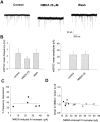Presynaptic NMDA receptors modulate glutamate release from primary sensory neurons in rat spinal cord dorsal horn
- PMID: 15028770
- PMCID: PMC6729523
- DOI: 10.1523/JNEUROSCI.4637-03.2004
Presynaptic NMDA receptors modulate glutamate release from primary sensory neurons in rat spinal cord dorsal horn
Abstract
NMDA receptors have the potential to produce complex activity-dependent regulation of transmitter release when localized presynaptically. In the somatosensory system, NMDA receptors have been immunocytochemically detected on presynaptic terminals of primary afferents, and these have been proposed to drive release of substance P from central terminals of a subset of nociceptors in the spinal cord dorsal horn. Here we report that functional NMDA receptors are indeed present at or near the central terminals of primary afferent fibers. Furthermore, we show that activation of these presynaptic receptors results in an inhibition of glutamate release from the terminals. Some of these NMDA receptors may be expressed in the preterminal axon and regulate the extent to which action potentials invade the extensive central arborizations of primary sensory neurons.
Figures






References
-
- Alvarez FJ (1998) Anatomical basis for presynaptic inhibition of primary sensory fibers. In: Presynaptic inhibition and neural control (Rudomin P, Romo R, Mendell LM, eds), pp 13–50. New York: Oxford UP.
-
- Bardoni R, Belluzzi O (1993) Kinetic study and numerical reconstruction of A-type current in granule cells of rat cerebellar slices. J Neurophysiol 6: 2222–2231. - PubMed
Publication types
MeSH terms
Substances
Grants and funding
LinkOut - more resources
Full Text Sources
